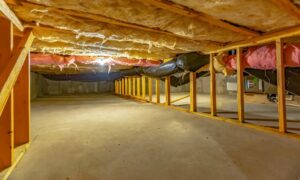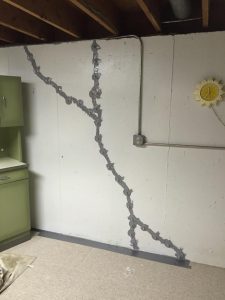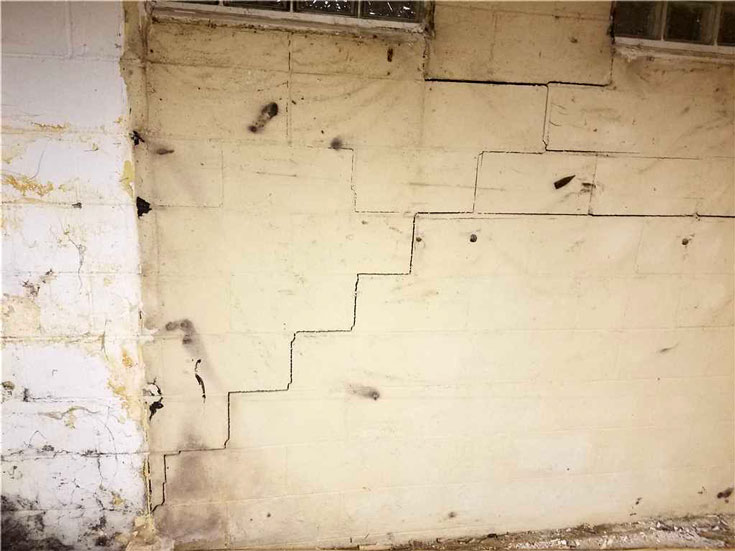Stair Step Cracks and Their Significance in a Home’s Foundation: Causes, Effects, and Remediation
Stairstep cracks in a home’s foundation are a cause for concern for homeowners and can indicate underlying structural issues. These distinctive cracks that resemble a series of steps are not only unsightly but can lead to significant problems if left unaddressed. 
Understanding Stair Step Cracks in a Home’s Foundation
What are Stair Step Cracks?
Stair step cracks are vertical cracks that form a pattern resembling a set of stairs or steps. These cracks commonly appear in masonry or concrete block foundations and can be observed in basement walls, exterior walls, or crawlspace walls. The distinct pattern of stair step cracks makes them easily recognizable and raises concerns about the foundation’s stability.
Identifying Stair Step Cracks
To recognize stair-step cracks, homeowners should conduct regular inspections of their foundation walls. These cracks often originate from the corners of windows or doors and may extend both vertically and horizontally, following the mortar joints in a step-like fashion. Homeowners should also pay attention to any widening or changes in the crack’s appearance, as this can indicate ongoing foundation movement.
Causes of Stair Step Cracks
Soil Settlement and Shifting
One of the primary causes of stair-step cracks is soil settlement and shifting. As the soil beneath a home’s foundation settles over time or experiences changes in moisture content, it can cause the foundation to move, leading to the formation of stair-step cracks.
Foundation Heaving
In colder climates, frost heaving can be a contributing factor to stair step cracks. Frost heaving occurs when the soil freezes and expands, exerting pressure on the foundation. Once the soil thaws, it contracts, leading to uneven settling and potential stair step cracks.
Hydrostatic Pressure
Hydrostatic pressure can also be responsible for stair step cracks. Excessive groundwater around the foundation can exert pressure on the walls, causing them to shift and crack in a stair step pattern.
Poor Foundation Construction
In some cases, stair step cracks can be attributed to subpar foundation construction. Insufficient reinforcement, inadequate concrete curing, or improper concrete mixing can lead to weaknesses in the foundation, making it susceptible to cracks.
Effects of Stair Step Cracks on a Home’s Foundation
Structural Integrity
Stair step cracks can compromise the structural integrity of a home’s foundation. As these cracks continue to widen and deepen, they weaken the foundation’s load-bearing capacity, potentially leading to significant structural damage.
Water Infiltration
Stairstep cracks can create pathways for water to seep into the basement or crawlspace, causing water infiltration and moisture-related issues. This can result in mold growth, decay of wooden components, and compromised indoor air quality.
Aesthetics and Property Value
Beyond functional concerns, stair step cracks can negatively impact the aesthetics of a home and reduce its market value. Potential buyers may be discouraged by the presence of foundation cracks, even if they have been repaired, leading to challenges in selling the property.
Foundation Inspection
The first step in remediation is to conduct a thorough inspection of the foundation and stair step cracks. A professional structural engineer or foundation specialist should assess the severity of the cracks, identify the underlying cause, and recommend appropriate remedies.
Epoxy Injection
For smaller, stable stair-step cracks, epoxy injection can be an effective repair method. This process involves injecting epoxy resin into the cracks, filling voids, and bonding the concrete together.
Carbon Fiber Reinforcement
In cases where stair-step cracks indicate ongoing foundation movement, carbon fiber reinforcement can be employed. Carbon fiber
Foundation Underpinning
Foundation underpinning may be necessary for severe stair-step cracks resulting from significant settlement or shifting. This process involves extending the foundation deeper into stable soil or installing piers or helical anchors to stabilize the structure.
Exterior Waterproofing
To address hydrostatic pressure and water infiltration, exterior waterproofing can be applied to the foundation walls. This involves applying waterproof coatings or membranes to prevent water from reaching the foundation.
Stair step cracks in a home’s foundation are an important warning sign of potential structural issues that require prompt attention. Understanding the causes, effects, and remediation options for stair-step cracks can help homeowners take proactive measures to protect their investments. Regular inspections and early intervention are crucial for maintaining the stability and integrity of the foundation, ensuring the safety and longevity of your home. Remember to consult with a qualified professional for a thorough assessment and personalized solutions based on your specific foundation and crack severity.

